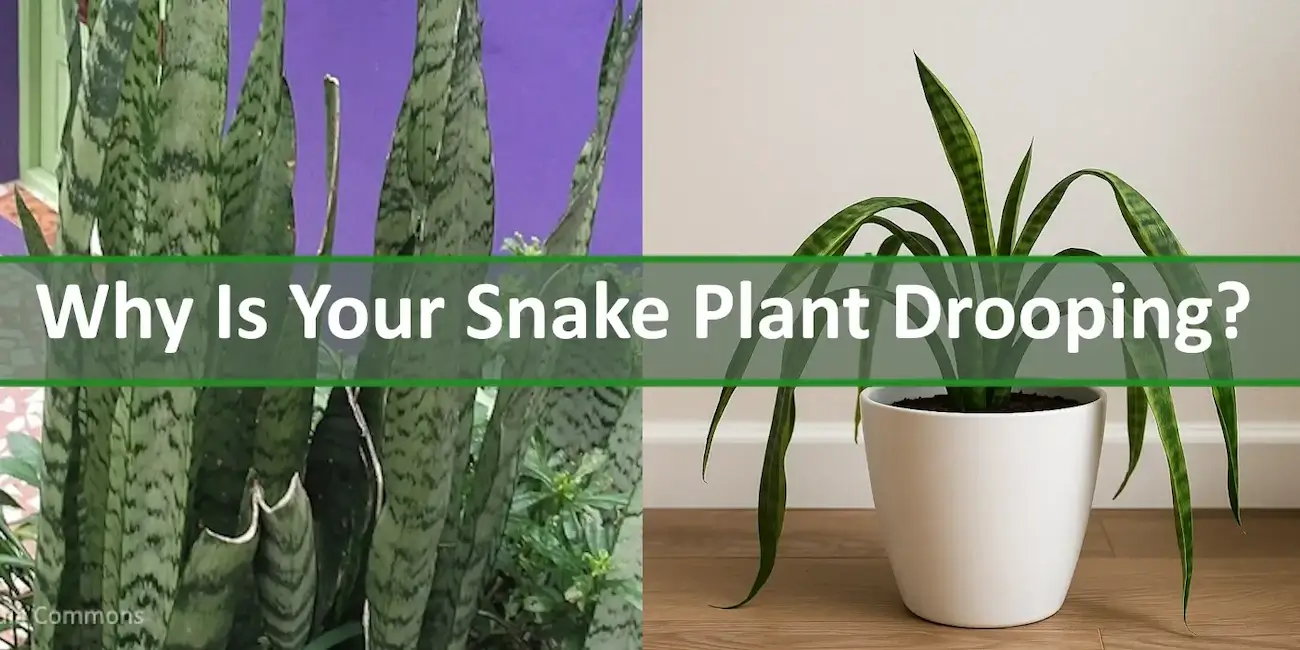
Why Is Your Snake Plant Drooping: 11 Reasons And How to Bring It Back Fast

Snake plant drooping? Nine times out of ten, it’s water or light. Check the soil, roots, and light distance. Fix the moisture first, then adjust the light and the pot. Snake plants are tough—correct the cause, and new leaves will look like new.
Snake Plant Drooping: Quick Diagnosis
| Cause | Quick Test | Fix |
|---|---|---|
| Overwatering & Root Rot | Soil stays wet; base mushy or smelly | Unpot, trim rot, repot in fast-draining mix; water only when dry |
| Underwatering | Soil bone-dry; leaves wrinkled, soft | Soak through; resume deep, infrequent watering |
| Light Problems | Far from windows or sunburned patches | Move to bright, indirect light |
| Temperature Stress | Near drafts, heaters, AC vents | Keep 18–29°C; move from drafts/heat blasts |
| Rootbound Pot | Roots circling; water runs around edges | Repot into a container 1–2” larger |
Here’s the thing: Dracaena trifasciata is a hardy houseplant, practically a desert plant in disguise. If it’s sagging, something’s up. Could be harmless… could be one of those common culprits that quietly wrecks a root ball. Either way, ignoring it won’t bring those upright leaves back.
Table of Contents
- How to Tell If Your Snake Plant Is Really Drooping
- Diagnosis Flow: Match the Symptom to the Culprit
- 11 Common Culprits for Snake Plant Drooping (and How to Fix Each One)
- Overwatering and Root Rot: Why Your Snake Plant’s Base Turns Mushy
- Underwatering: How Drought Stress Leads to Droopy Snake Plant Leaves
- Light Problems: Too Much Direct Sun or Not Enough Indirect Light
- Temperature Stress: How Cold Drafts and Heat Sources Trigger Leaf Collapse
- Wrong Pot Size or Rootbound Roots: When the Container Causes the Droop
- Post-Repot Shock: Why Snake Plants Slump After a Move
- Bloom Stress: The Hidden Cost of Snake Plant Flowers
- Pest Damage: Spotting Cotton-Like Clusters Before Droop Gets Worse
- Mechanical Damage: Preventing Bends From Bumps and House Maintenance Matters
- Seasonal Dormancy Slouch: The Winter Slowdown Other Guides Miss
- Overfertilizing: How Too Much Food Weakens Your Snake Plant
- Prevention Habits for Upright Snake Plants
- When to Prune vs Stake Drooping Leaves
- Why Is My Snake Plant Drooping? FAQs
I’ve seen drooping snake plant leaves from cold drafts, mushy leaves from root rot, and even post-bloom flops that fooled experienced plant owners. So we’re going to run through every possible reason — from the obvious (frequent watering) to the sneaky (soil compaction) — and map out quicker revival steps so yours stays photo-ready.
Why Is My Snake Plant Drooping?
A snake plant droops when stressed by water issues, poor light, pests, or root problems. Overwatering often causes soft, mushy bases, while underwatering leaves edges crispy. Drafts, repot shock, and bloom stress also trigger collapse. Adjust care and most plants recover.
Drooping is one symptom, but care basics determine if your plant thrives in the long term. Find the full breakdown in my snake plant care guide.
How to Tell If Your Snake Plant Is Really Drooping
Knowing what to do if you notice a plant with drooping leaves is tricky. This is where new plant parents sometimes panic. Snake plants naturally lean a little as leaves develop, especially if they’re 1–2 inches larger than the pot’s ideal height. That’s just healthy root expansion doing its thing.
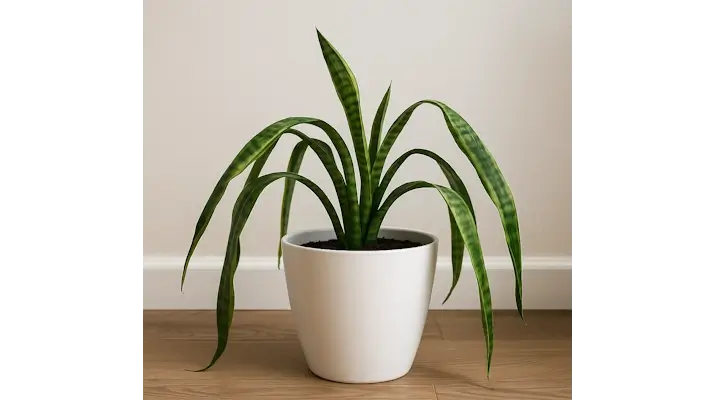
True snake plant droop looks different. The bend usually happens lower down, near the base of the leaf, and the leaf color may dull. Sometimes the root ball’s unstable, or you’ll feel softness at the fold — a secondary symptom of mushy leaves or hidden pests like spider mites.
Forum favorite tip? Gently pinch the leaf where it’s bending. If it’s firm, it’s likely just leaning toward indirect light or adjusting to indoor conditions. If it’s soft or smells off, grab fresh, well-draining soil and check those drainage holes. A noticeable smell can be your first warning sign of root rot.
Not all drooping comes from weak roots—sometimes it’s yellowing leaves sending a stress signal. Check out our full guide on why snake plant leaves turn yellow and what to do next.
11 Common Culprits for Snake Plant Drooping (and How to Fix Each One)
Droopy snake plant leaves aren’t random — they’re signals. Each bend, slump, or lean has a cause, from root rot to seasonal dormancy. The trick is spotting the culprit before damage sets in. Here’s how to match symptoms to problems and give your snake plant a quicker revival.
Overwatering and Root Rot: Why Your Snake Plant’s Base Turns Mushy
Snake plants like to dry between drinks. Constant moisture suffocates roots and softens the base. Check for a sour smell, brown roots, or soil that never dries. Unpot, cut mushy roots, dust cuts with cinnamon or sulfur, and repot in a chunky, fast-draining mix. Water only when the mix is fully dry.
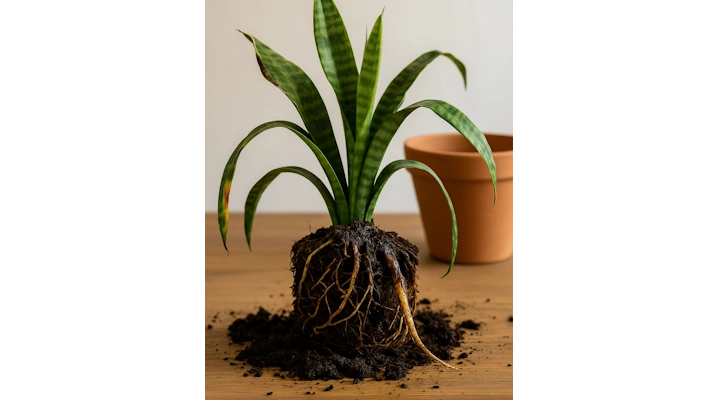
Noticed your snake plant’s leaves twisting instead of drooping? That’s another stress signal. Here’s why snake plant leaves curl and how to fix it before damage sets in.
Underwatering: How Drought Stress Leads to Droopy Snake Plant Leaves
Extended drought collapses cells. Leaves start bending and appear wrinkled, and soil is dust-dry. Bottom-water or soak until runoff. Let excess drain. Resume deep, infrequent watering based on dryness, not a calendar. In winter, stretch the intervals longer.
One forum user joked their “snake plant looked like it was holding its breath,” which is exactly how it feels to the plant — no drink of water means no turgor pressure to keep those leaves upright. You might also notice the soil pulling away from the pot sides, leaving gaps big enough to slip a finger into.
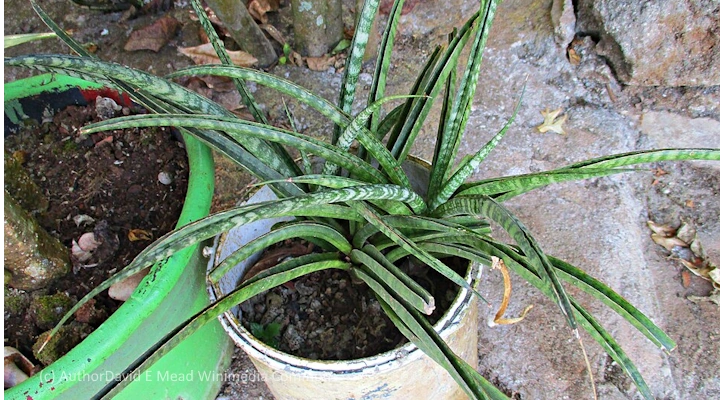
My top tip: Match your watering to the season: warmer months mean a little more, winter means a lot less. Always check before you pour — guessing is how stories about droopy snake plant leaves start.
Light Problems: Too Much Direct Sun or Not Enough Indirect Light
Too dark, and leaves lean, then droop. Too much midday sun can scorch and weaken blades. Aim for bright, indirect light a few feet from an east or west window. Rotate monthly. If leaves curl instead of droop, compare with your Curling guide for a better match.
Seasonal tip: Shift it closer to light in winter when days are shorter, but ease it back in warmer months to avoid sunburn.
Temperature Stress: How Cold Drafts and Heat Sources Trigger Leaf Collapse
Cold snaps and hot blasts shock tissues. Watch spots near doors, AC, radiators, or space heaters. Keep it steady at 60–85°F (18–29°C). Move the plant, lift it off cold floors, and avoid sudden swings, especially in winter.
Wrong Pot Size or Rootbound Roots: When the Container Causes the Droop
Tight roots can repel water down the sides, leaving the core dry. Or a big pot holds moisture too long. Pick a pot 2–3 cm wider than the root mass, with a drainage hole. Tease circling roots, pot in a gritty mix, and water through once.

If roots are crowded, dividing the plant can help. Check our step-by-step Snake Plant Propagation guide for safe repotting and division methods.”
Post-Repot Shock: Why Snake Plants Slump After a Move
Root handling and fresh soil shift water balance. Leaves can droop for a week or two. Keep light bright but gentle, water lightly once, then wait for top-to-bottom dryness. New upright leaves signal recovery.
Bloom Stress: The Hidden Cost of Snake Plant Flowers
Blooming takes energy. After flowers, older leaves may slump. Snip the spent stalk at the base. Keep the light bright, water the plant when dry, and avoid repotting for a month. If leaves yellow rather than droop, hop to your Yellowing guide.
One horticulture specialist at Colorado State University explained that this is normal for a desert plant adapting to stressful conditions. After the spike fades, leaves often bounce back, but some may never stand upright again.
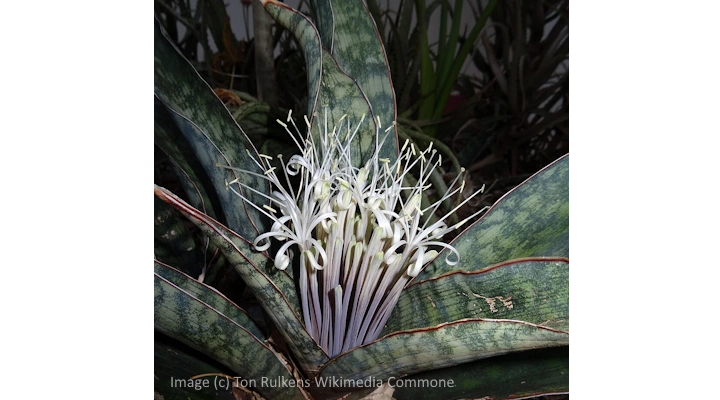
If you haven’t seen your plant flower yet, my guide to snake plant flowers walks you through why they bloom, what to expect, and how to care for them during the process.
Pet owners take note — both leaves and flowers contain compounds that can cause irritation in cats and dogs. While drooping leaves are usually a sign of watering or light issues, if your cat’s been chewing, check this snake plant toxicity guide for cats to spot the warning signs.
Pest Damage: Spotting Cotton-Like Clusters Before Droop Gets Worse
Mealybugs and scale sap strength and cause collapse. Look for cottony tufts, bumps on leaves, or sticky honeydew. Isolate. Wipe with isopropyl on cotton swabs, then use your preferred treatment plan. Recheck weekly for a month.
Plant experts at PennState Extension say that spider mites and mealy bugs often affect snake plant health. The biggest problem? By the time most people notice them, the damage is done. Early signs can be subtle: a slight lean, slower recovery from drooping, or leaves that feel limp despite healthy root expansion.
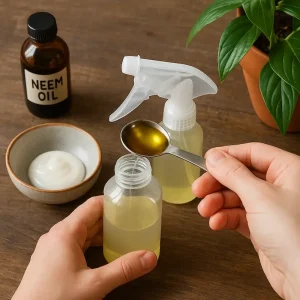
For a full guide on treatments, see my article on using neem oil for houseplants.
Mechanical Damage: Preventing Bends From Bumps and House Maintenance Matters
One random leaf folded? That’s a crease from a bump, tie, or cleaning day. It won’t unfurl. Trim at the base with clean shears. Space the pot away from busy walkways and curious paws. Protect your plant with “How to keep cats away from snake plants”—quick barriers, gentle deterrents, and distraction tactics.
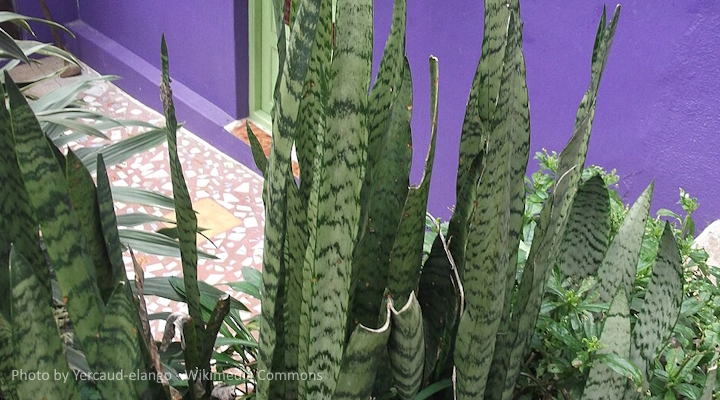
Chewing and stress can trigger sagging leaves and cause mechanical issues. Not only that, snake plants contain toxic compounds that can be harmful to cats. Drooping leaves are one thing—but pet safety is another. Here’s what to know if your cat licks a snake plant.
Seasonal Dormancy Slouch: The Winter Slowdown Other Guides Miss
Cool rooms slow development and water use. What happens? Plant parents tend to overwatering in winter. Keep temps comfortable, give bright light, and water far less. Expect slower bounce-back until spring.
Overfertilizing: How Too Much Food Weakens Your Snake Plant
Salt buildup pulls water from roots and burns tips. Look for crust on soil and brown margins. Flush the mix thoroughly or repot. Feed lightly in active months only. Skip fertilizer in winter.
How to Revive a Drooping Snake Plant (Quick Rescue)
Confirm the cause with the table. If rot is present, unpot and correct immediately. If the soil is heavy, repot into a gritty succulent mix. Move to bright, indirect light. Water deeply, then wait until fully dry. Stake only if needed for aesthetics; new leaves will stand without help.
Drooping isn’t about how tall a snake plant can grow — it’s a stress signal. If you’re curious about maximum height and variety differences, see my How Big Do Snake Plants Get guide
Preventing Future Snake Plant Droop
Water on dryness, not dates. Use a fast-draining mix and a pot with a drainage hole. Keep light bright and steady. Avoid drafts and heat blasts. Fertilize lightly in spring and summer. For overlapping symptoms, link to Curling or Yellowing so readers land on the right fix.
The University of Georgia Extension points out that consistent care is what lets these hardy houseplants thrive for years without fuss. I’ve shared the same in my gardening newsletter because it’s one of those gardening tips worth repeating — small adjustments now prevent big problems later.
When to Prune vs Stake Drooping Leaves
Not every droopy snake plant leaf needs to be cut. If the leaf is still firm, staking can give it support while the plant recovers. Bamboo stakes or slim moss poles work well — just anchor gently into the soil without damaging the root ball.
If a leaf is soft, creased, or showing secondary symptoms like yellowing, pruning is the better choice. Cut it clean at the base with sterile scissors. This redirects energy to healthy leaves and encourages new shoots.
As Justin Hancock from Costa Farms notes, “removing damaged leaves is like clearing the stage for healthy new leaves.” Andrea Peck at UC Master Gardeners adds that keeping a snake plant spritely just as much about removing weak foliage as it is about preventing future stress.
Why is My Snake Plant Drooping? FAQs
Why is my snake plant drooping after repotting?
Post-repot shock is common. Roots need time to re-anchor, and leaves may slump temporarily. Keep it in bright, indirect light, avoid overwatering, and give it a few weeks to recover.
Can a drooping snake plant recover?
Yes — if the cause is addressed early. Trim damaged leaves, correct light or watering issues, and use fresh, well-draining soil. Healthy roots will produce upright new leaves.
Does low light make snake plants droop?
Prolonged low light can cause leaves to lean and thin out. Snake plants do best with bright, indirect light, though they can tolerate some shade.
Should I cut drooping snake plant leaves?
Cut only leaves that are soft, creased, or damaged. Firm leaves can be staked for support until the plant regains strength.
Why are my snake plant leaves folding inward?
Leaf folding often signals underwatering or very low humidity. Water deeply, let excess drain, and keep the plant away from heat vents.
Do snake plants droop in winter?
Yes — seasonal dormancy can cause a slight lean without any real damage. Reduce watering, keep it away from cold drafts, and normal posture should return in spring.
Most drooping snake plants aren’t lost causes — they’re just sending up a flag. Once you spot the culprit and tweak the care, those firm, upright leaves usually follow.
If you’re still scratching your head, my Why Is My Plant Drooping? guide walks through fixes for other houseplants that slump, fold, or lean. And if your snake plant’s looking healthy again, you might enjoy reading about the benefits of keeping a snake plant around — from air quality to low-maintenance beauty.
Either way, the next time you catch yours starting to slouch, you’ll know exactly what it’s asking for.
